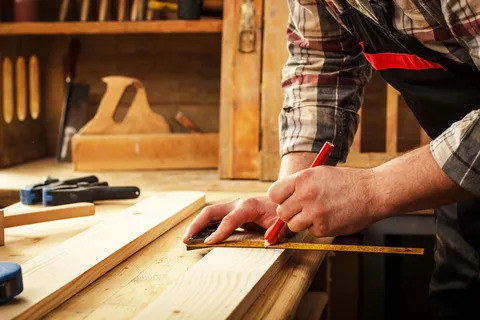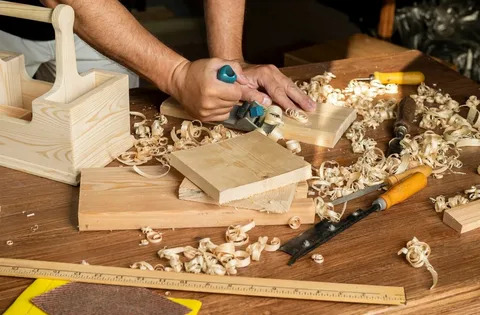
Inspiring Examples of Top Trends Carpentry Contractors to Upgrade Your Property
A trendier, more updated look for your home can be propagated to a great extent by considering the most current trends in carpentry. These trends—from sustainable materials and one-off built-ins to minimalist designs with smart home integrations—open a completely different perspective on how to remodel your space. These include creating multi-functional areas, high-end finishes, and remodeling outdoor spaces. These inspiring examples show what skilled carpentry can do. Keep current, and work with a knowledgeable contractor to keep your property stylish and current. Ready to upgrade? Consult with a trustworthy carpentry contractor today to bring these trends alive in your home.
Modern Carpentry Trends Overview
This new era of woodworking is all about becoming sustainable, functional, and design-led. Some main trends include eco-friendly materials in the form of reclaimed wood, which is not only useful for the environment but also offers unique aesthetic value. Clean lines and simplicity of design bring elegance to any space by keeping it clutter-free. Custom built-in furniture maximizes space efficiency while providing personalized touches to homes. Furthermore, smart home integration is changing the face of carpentry with technology for improved ease and safety. These trends showcase a shift toward making spaces not just beautiful but also practical and ecologically aware, with consideration for modern demands in living.

Sustainable and Eco-Friendly Materials
Sustainable and eco-friendly materials are indeed at the helm of carpentry today, looking directly toward environmental accountability. Reconstituted from wastes, these materials, in addition to reclaimed wood and bamboo, reduce impacts on the environment. They come with durability and unique aesthetics that make them a wise choice for any modern carpentry job. With the choice of such materials, one works toward a greener tomorrow and enhances both aesthetic appeal and value for one’s property.
- Benefits of Sustainable Materials
One of the fast-growing trends is in sustainable materials—like reclaimed wood and recycled metal—for their environmental benefits. Such materials reduce waste, save natural resources, and, very often, have a reduced carbon footprint. With these sustainable alternatives, homeowners can contribute towards preserving the environment while constructing long-lasting, superior products that give character and distinction to any property.
- Popular Eco-Friendly Carpentry Materials
Some of the eco-friendly materials for carpentry include bamboo, reclaimed wood, and FSC-certified lumber. Bamboo is very fast-growing and self-renewing; reclaimed wood provides new use to old material, hence decreasing deforestation, while FSC-certified lumber ensures responsible forest management. Accordingly, such materials provide an added sustainability dimension and unique aesthetics that can set any carpentry works above others.
- Incorporating Eco-Friendly Materials in Design
Carpentry design with eco-friendly material integration does not have to be unattractive. For instance, reclaimed wood gives interiors rustic charm, while bamboo presents sleek and modern appeal. Designers could also use recycled glass and metal to create unique sustainable accents. All these uses are according to the trends that have taken over nowadays and include environmental-friendly solutions without compromising on aesthetic appeal and durability.
Minimalist Design Aesthetics
Minimalist design aesthetics is about simplicity, functionality, and clean lines, which give openness and a lack of clutter to a space. Focusing on quality over quantity, minimalist carpentry is about well-made and purposeful elements that will fade into their environment. Not only are the looks given better to a space, but it is very calm and orderly in nature—just the right kind of trait one wishes to imbibe for modern living.
- The Core Principles of Minimalist Design
Simplicity and cleanliness in the midst of functionality are the hallmarks of minimalist design. It emanates the philosophy “less is more” through the elimination of clutter, creating spaces that are at once beautiful and usable. Via neutral colors and very streamlined forms, minimalist design creates a surrounding calm and clarity for every single element to play its role.
- Benefits of Minimalist Design Aesthetics
In its appropriateness to the aesthetic of minimalist design, there are numerous benefits that bring about a cleaner and more peaceful way of life. Removing clutter and emphasizing meaningful design helps create a sense of space in one’s living area. This also facilitates maintenance, as fewer objects and less complex designs will require less maintenance over time. This will no doubt contribute to functionality and visual harmony in design.
- Incorporating Minimalism into Carpentry Projects
This means that a carpentry project incorporating minimalism would be characterized by a strong emphasis on precision, good material, and well-thought-out layouts. Built-in storage devices and furniture that can be used for many things are typical, as well, since they save space while giving the impression of a clean look. Natural wood finishes and subtle textures bring warmth without overwhelming the design. Such careful balancing will help create a classic, graceful result, totally in keeping with the parameters of minimalism.

Smart Home Integration
Smart devices and systems integrate to offer a modern lifestyle convenience and efficiency not previously achieved. Starting from the simplest automatized lighting and climate control to sophisticated security systems, smart technology offers superior control for a homeowner over their environment. Bringing these systems together in best carpentry works creates added property value and gives added value to the ways of living.
- Benefits of Smart Home Integration
Smart home integration holds all the desirable properties: convenience, energy efficiency, and better security in the running of everyday life. Homeowners can control lighting, temperature, and security features of the house from a single device, mostly remotely. It’s not just easier to go about daily tasks, but owners are also formed into savings and peace of mind through these technological advancements, adding great worth to any modern home.
- Key Features of Smart Home Technology
Some of the key features of smart home technology include automated lighting, smart thermostats, and advanced security systems. It puts together several elements which work in concert to create a seamless, responsive living environment. For instance, smart lighting adjusts depending on occupancy or time of day, while security cameras monitor activities in real-time. All these features work together to improve comfort, safety, and efficiency in a home.
- Incorporating Smart Technology in Carpentry
Smart technology integration can be reflected in the design of specific areas for a variety of installed systems, such as hidden wiring associated with automated controls or built-in charging stations. Smart hubs are easily hidden within custom cabinetry; smart locks fit within a door without interference. These thoughtful additions help smart technology fit in effortlessly and promote functionality alongside style.
Reclaimed Wood Usage
Reclaimed wood usage has been increasingly popular because it helps in the conservation of the environment by offering unique aesthetic appeal. For example, reusing old wood from barns, factories, or any other building brings along a lot of character and history into the modern design. Such sustainable material does not just reduce waste but also adds distinguished rustic elements into a house while mixing tradition with contemporary style.
- Environmental Benefits of Reclaimed Wood
Harvesting reclaimed lumber for new uses protects trees by decreasing the need to deforest and minimizing the impact on the environment that new construction has. Several natural resources are conserved by reusing existing materials, and less waste is created. In most cases, reclaimed wood needs very little processing, which reduces energy consumption. Sustainable reclaimed wood offers both strong and long-lasting options for building and design projects.
- Beauty in Reclaimed Wood
Reclaimed wood creates a unique aesthetic that will add warmth and character to any space. Its weathered texture and rich patina reflect a rustic, lived-in feel that is hard to create with new materials. Each piece of reclaimed wood brings forth a story into furniture, flooring, or accent walls with added history and singularity, hence very outstanding in modern interiors.
- Bringing Reclaimed Wood into Design
Such design projects involving reclaimed wood require creativity in using such versatile material: stunning flooring, exposed beams, or custom furniture. Reclaimed wood can also be used to create beautiful accent walls or shelving that add texture and warmth to any room. Its adaptability allows it to blend seamlessly with both traditional and modern designs, improving them.
Innovations in Outdoor Carpentry
Outdoor carpentry innovations offer creativity and functionality for outdoor spaces. These include pergolas, outdoor kitchens, custom decks, and seating areas that aid in maximizing the functionality of outdoor living space. Contemporary materials and methods used in their construction make finished products sturdy and beautiful, hence diversifying outdoor spaces by usage. These are developments in carpentry materialized into new ways of extending and personalizing outdoors.
- New Materials Used in Outdoor Carpentry
Innovations in outdoor carpentry include very resilient and weather-resistant materials that most people use today, like composite decking and treated timber. Very durable and low maintenance, these materials still allow for a natural look and withstand the harshest of weather conditions, resisting rot. Ideal for decking, pergolas, and outdoor furniture, they will keep your outdoors beautiful and functional for years.
- Creative Outdoor Living Spaces
Outdoor carpentry innovations redefine how exterior spaces can be used in the creation of functional and stylish outdoor living spaces. Custom-built decks, pergolas, and outdoor kitchens extend square footage right into your backyard. These inventive solutions create comfortable areas where you can dine, entertain, or relax—all while turning your backyard into a warm and inviting outdoor extension of your indoor living space.
- Sustainable Outdoor Carpentry Practices
Sustainable outdoor carpentry makes use of eco-friendly materials and designs that reduce the impact on the environment. This involves the use of salvaged wood, recycled composites, and sustainably harvested timber. Added to this is the creative concern of designing outdoor structures to blend into the natural landscape to help in preserving the environment. A nutshell view of the environmental sustainability of the improvement intervention gives these innovations assurance for environmentally sensitive outdoor carpentry works attaining beauty.

Conclusion
In conclusion, the new trends in carpentry can raise the aesthetic and functional values of property. Ranging from eco-friendly materials and minimalistic design to smart house technologies and using reclaimed wood, the trends are toward eco-friendliness, practicality, and modern ways of life. By engaging professional carpentry contractors, you can adopt these new ideas into your home without much hassle and thus create spaces that are not only beautiful but also in sync with modernity. Whether you’re looking to enhance your interior or upgrade your outdoor spaces, these trends offer inspiring possibilities for any renovation project. Now is the time to consult with a professional to bring these ideas to life.
